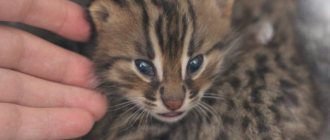The civet fishing cat, also known as the speckled or fish cat, lives in Southeast Asia. Outwardly similar to other wild cats, but differs from them in its unusual lifestyle, habits and diet. The civet cat can often be found in zoos; it is not suitable as a pet for a number of reasons.
Appearance
The civet fishing cat is a large predator, although it weighs less than a panther and a leopard. The weight of an adult cat reaches 10 kg, and that of a cat – 15 kg. The length of the animal, including the tail, is 1 m 20 cm, but the tail accounts for only one quarter of the total length of the fishing cat, no more. The tail itself has the same thickness from base to tip. The cat's physique, like that of any other real predator, is muscular and squat. The paws are thick and short, but strong, thanks to them the fishing cat defeats opponents larger than himself in a fight. In general, this animal is very graceful, has great strength and the swiftness of a leopard.
The fishing cat's muzzle is slightly elongated. The head is wide and large, and the neck is very short, and therefore the head seems to immediately merge into the body. The head is crowned with movable small rounded ears. They are pressed to the head and because of this they give the cat’s appearance aggression. The cat's eyes are large, with a vertical pupil. You can feel absolute confidence in your abilities in your gaze. You may hear about fishing cats as “the pit bull of the cat world” - this is what they are called because of their very strong jaws. But the most important thing that distinguishes the civet fishing cat from cats of other breeds is its unusually shaped nose. It is very wide and large, there is practically no bridge of the nose. This nose structure helps the cat well in hunting when it swims and dives. The cat takes a deep breath and holds its breath, but no water gets into its nose.
The fur of the civet fishing cat is hard and short, but waterproof. The coat color is olive-gray, matte, with black spots and stripes arranged in a row. This color is perfect for a cat, as it can easily blend in with the vegetation in its habitat.
How do fishing cats get food?
This animal leads a twilight and nocturnal lifestyle, and during the day it sleeps in the grass or bushes. He is not a fan of climbing trees, but he loves to fish. In the process of catching fish, the civet fishing cat wanders through the shallow water and picks up fish with its strong paws with very sharp and large claws. His movements are lightning fast.
Also, when hunting on water, a cat can resort to cunning: keeping its body completely motionless, it lightly touches the water, imitating the movements of insects. The fish are interested in such movements, it swims to the surface, where the cat grabs it.
But these cunning predators fish not only in shallow water; they feel no worse in the depths. They can easily cover long distances in water. And all thanks to the membranes present between the claws on the paws. Because of the membranes, it is more difficult for the animal to retract its claws, but they are the main assistants in catching fish. The civet fishing cat can dive in the water when chasing prey. At the same time, it presses its ears very tightly to its head, thereby protecting itself from water getting into them. As it turns out, cats have many different techniques that they use when catching fish.
For entertainment, these animals search for snails and frogs in shallow water. A very fun way to entertain yourself.
The civet fishing cat feeds on what it catches: crayfish, snakes, fish. On land it catches insects, birds, and, less commonly, mammals no larger than a lamb.
Character and behavior
In the wild, the civet fishing cat is very careful, avoids meeting people in every possible way and, if possible, will not enter into conflict, but will always be able to stand up for itself. Many people talk about their aggressiveness and assertiveness. Local residents tell many stories about fishermen who entered settlements, were not afraid of anyone and easily dispersed a pack of dogs. There is a myth in Singapore that a baby was carried away by a fish cat. However, there is no documentary evidence of this. But there is another true fact. In one zoo, a very large male escaped from his cage and ended up with a leopard, which he killed in a fight.
The civet fishing cat can meow and hiss, and also makes other interesting sounds that vaguely resemble laughter, barking, or a short abrupt yelp. They are difficult to describe, but can be heard in the video. The main occupation of the fisherman is rest and sleep; in his free time, the animal wanders through shallow water in search of food or hunts small terrestrial animals. In zoos, civet cats lead a moderately active lifestyle, they can frolic a little, but generally they do not waste energy. They can climb trees, but do not like to climb high on branches. Rookeries are built on the ground or rest at low altitudes.
Is it possible to keep a civet cat at home?
Through their activities, people are slowly but surely destroying places suitable for the life of these cats: they drain swampy areas of the area, cut down forests so that they become suitable for agriculture, expand existing human settlements and build new ones. The result of all these actions is the deterioration of living conditions for the civet fishing cat, which only contributes to the extinction of these unique animals in the near future.
Breeding these felines is prohibited in almost all countries of the world. And due to the complex nature of the animal, people who decide to purchase it may have a lot of problems. More than one generation of predatory cats living in the natural environment often comes into conflict even with similar fishing cats, not to mention other inhabitants of the wild environment.
There are no guarantees that a fishing cat, who came into the family as a small kitten, will not have conflicts with its owner when it becomes an adult. A cat will need a special approach, so in matters of education it is better to seek help from specialists who know everything about keeping it at home. They will be able to give useful advice and all the necessary knowledge.
Lifestyle and nutrition of a fishing cat
Although these cats are famous for their aggressive, bullying behavior, in the wild they avoid human contact. The difference between the speckled cat and most other representatives of the cat family is their good adaptability to the aquatic environment. These animals hunt not only near the shore, but directly in the water, in shallow water.
Viverrid cats have a reputation as fighters and bullies, but they avoid meeting people.
It is not difficult to guess that the main product in the diet of a fish cat is fish. The speckled cat hunts by sitting on the shore and using its paw to dislodge passing fish onto the shore, or dives after it to the bottom in shallow places. In addition to fish, the cat eats frogs, snails, birds and snakes. On land far from the shore, the fishing cat sometimes hunts insects, mice and small mammals.
Rules for keeping a cat at home
Every year there are more and more nurseries for breeding civet fishing cats, and professional breeders are not afraid of the difficulties in obtaining permission to raise these exotic animals. Exotic lovers should purchase animals only from one of these nurseries. And after you have adopted a kitten, follow a number of rules for its care.
The ideal age for a kitten to be placed in a home is two months. As soon as the kitten was brought into the house, from the very first days of its life it must be fed by hand, so that it gets used to both the new home and its owner. The kitten should be with people all the time. Often people who have houses outside the city set up something like an enclosure on their property and place a kitten there. In this case, the animal will never truly get used to people and, alas, will not become pets.
The civet fishing cat, like any domestic animal, expects attention and affection from its owner. He also loves to play madly, but, being carried away by the gameplay, he may, without meaning to, scratch or even bite his owner. Under no circumstances should a cat be scolded, let alone beaten for this, because he will immediately defend himself. It is enough to simply strictly tell the cat “no” and blow in his face - cats cannot stand this. If the animal has done something wrong, then you need to leave it completely alone, for example, lock it in a room. A cat of this breed will quickly understand that the owner is offended by him, as this is a very smart animal.
The biggest problems begin with the onset of puberty in the civet fishing cat. We are talking about 2–3 years. The first sign of a male maturing is that he marks his territory, considering it his property. If the cat will not participate in breeding, it is best to neuter him before reaching eight months of age.
Since a fishing cat lives in a flock in its natural habitat, even when at home it will consider all family members to be its flock and demand attention from all people living in the house.
There is a known case when a civet fishing cat, having become an adult male, began to protect the “females”, i.e. the women living in the house, considering them his pack, from his owner - the “male” in the opinion of the cat. And the family had to give him to the zoo, although they really didn’t want to do this.
That's why it's best to get a regular house cat at home. Even if the family prefers large cats, you can find a pet of a breed whose representatives can reach a fairly large size.
Viverrid fishing cat in the wild
The civet fishing cat lives in tropical and subtropical regions of Southeast Asia, in Southeast India, Indochina, Sumatra, Ceylon, Java and Bali. Not to be confused with the jungle cat, which differs from the civet both in appearance and in its lifestyle. Fish cats settle near reservoirs, lakes, swamps and slow rivers, in general, wherever they can find food and not be seen by humans. An adult civet cat occupies a territory of 4-8 km2, the territory of males can reach 22 km2.
Fishing cats breed all year round. Pregnancy lasts 63-70 days. Litters are not numerous, usually 2-3 kittens are born. At 4.5 months, the young animals switch to adult food, and by 9 months they catch up with the size of their parents and switch to self-sufficiency. Reaches sexual maturity much later, at 2-3 years. In captivity, males help the female raise offspring; how they behave in the wild is not known for certain. And the rest of the way of life of civets has not been studied well enough.
Video about civet fishing cats:
Cost of a fishing kitten
To purchase this unique cat, which is a couple of times larger than a regular domestic cat, you will need to obtain special permission. This is due to the fact that the civet fishing cat is in the Red Book. As for the cost of a kitten of this breed, it reaches 300 thousand rubles. Not every Russian can afford to buy an animal for such a price. But it is important to understand that the purchase is only a tiny part of the amount that will have to be spent on maintaining this exotic animal.
Distribution and habitats of the fishing cat
The natural habitat is the subtropical and tropical climatic zones in Java, Sumatra, Indochina, eastern and southern India, and Ceylon.
In search of food, the cat waits for prey near the shore, and with one well-aimed jump rushes at the fish.
There are two subspecies of fishing cats, which differ only in the size of the animal. The first subspecies, whose representatives are small in size, inhabits the territory of the islands of Bali and Java.
The second, larger subspecies lives in Sumatra, on the coast of Southeast and South Asia up to Malacca, as well as on the island of Sri Lanka.
Within its natural habitat, the civet cat sticks to places with high humidity, such as coastal mangrove swamps and jungles.










